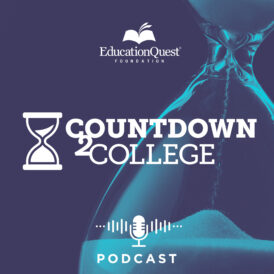
September 2, 2025 · Season 2 · Episode 5
Two Birds, One Course: The Benefits of Dual Credit
By Anders Peterson & Gage Boardman
Thinking about taking dual credit courses? In this episode, Gage and Lincoln Southwest High School Counselor Anders Peterson break down everything students need to know about earning both high school and college credit at the same time. From how dual credit works and the benefits it offers, to tips for deciding if it’s the right fit for you, this episode highlights why it can be such a smart move for your future.
Earning college credit while still in high school might sound too good to be true, but that’s exactly what dual credit courses make possible. In a recent episode of the Countdown2College podcast, Anders Peterson, a school counselor at Lincoln Southwest High School, shared how these classes work, why they’re worth considering, and what families should know before signing up.
What Dual Credit Really Means
“Dual credit doesn’t mean Harry Potter duel,” Peterson joked. Instead, it refers to earning two types of credit at once: one for high school and one for college. In practice, this means a student may take an English composition class at their high school, taught by a qualified teacher, and walk away with high school and college credit.
Saving Time and Money
One of the biggest draws, Peterson explained, is affordability. Dual credit courses are typically offered at a reduced tuition rate, sometimes with scholarships or school support covering part of the cost. Students not only save money compared to traditional college tuition, but they can also accelerate their timeline. By the time they start college, some students are technically sophomores—a common outcome for motivated students who load up on dual credit opportunities.
Building Confidence for College
Peterson noted another benefit: confidence. Students get a taste of what college-level rigor feels like while having the safety net of high school. This experience helps students learn how to manage expectations, deadlines, and coursework—skills that will serve them well once they’re full-time college students.
Challenges to Consider
Still, Peterson cautioned that dual credit isn’t a perfect fit for everyone. Some students underestimate the workload and quickly feel stretched too thin. Others assume all credits will automatically transfer, only to find that their new college won’t accept certain classes later. “It’s not just about taking as many as you can,” Peterson said. “It’s about taking the right ones, at the right time.”
How Families Can Decide if it’s the Right Fit
Peterson recommends that families start with a school counselor to map out options. High schools partner with different colleges, so the process and costs may differ depending on where you live. It’s also important to research transfer policies at the colleges a student is considering to ensure credits will count toward their degree.
Final Thoughts
Dual credit courses can open doors—saving money, saving time, and building confidence for the transition to college. But success depends on readiness and careful planning. With open conversations between students, parents, and school counselors, these courses can set the stage for a smoother and more affordable college journey.
